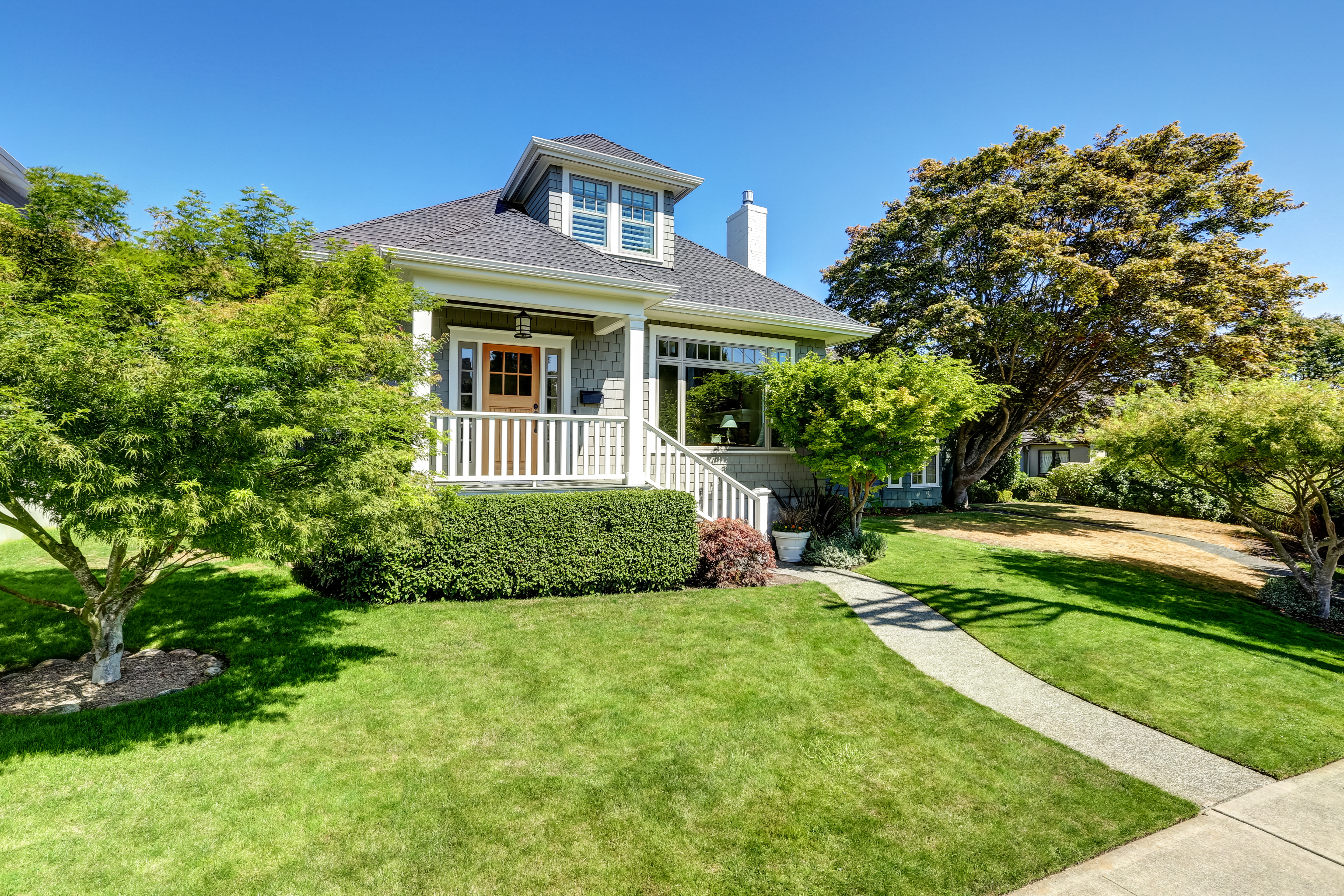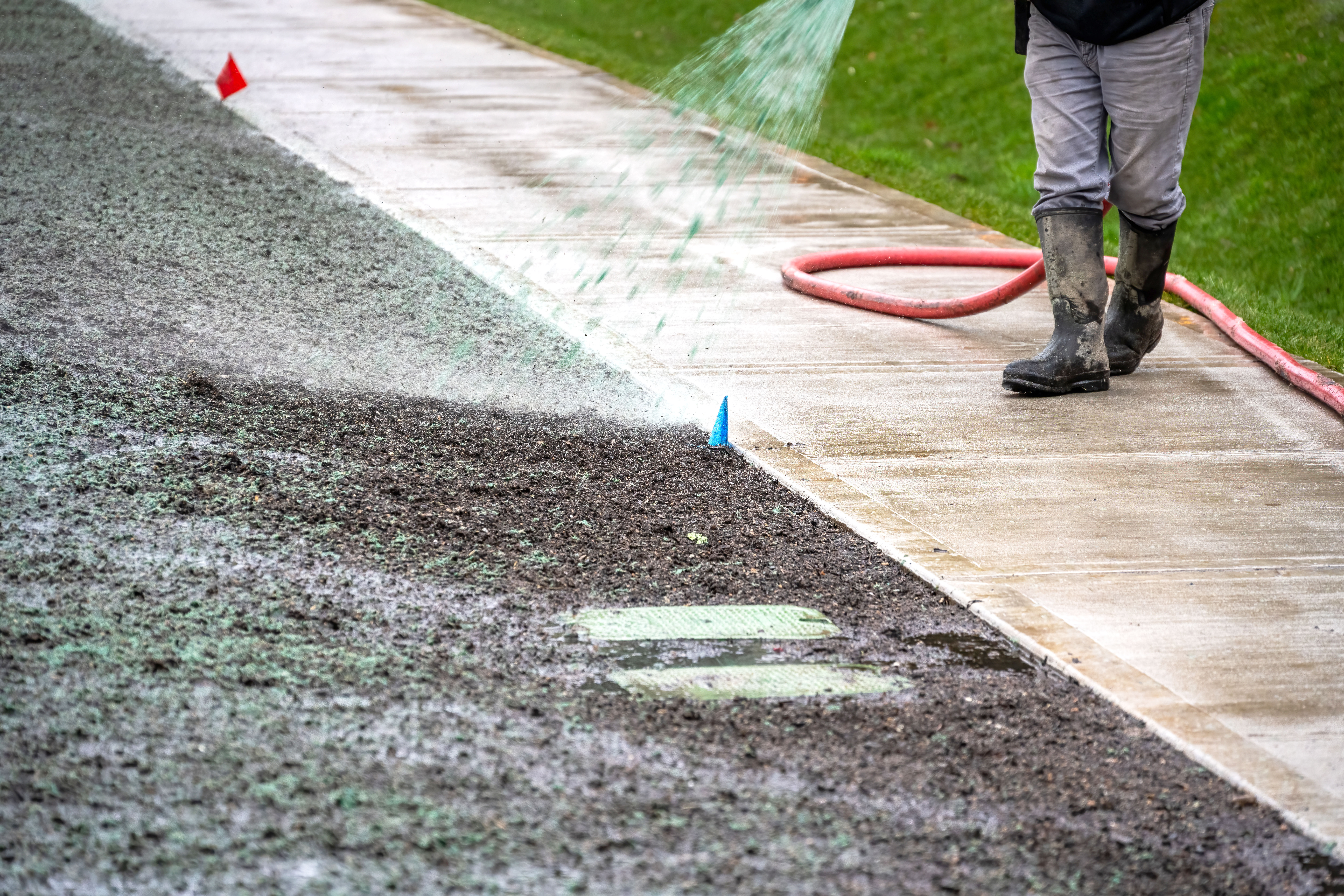
Removing an old lawn is often necessary to plant new grass or build a new outdoor structure. Find out what to budget for your lawn removal cost.
Grow lush, green grass with minimal effort


Hydroseeding sprays a nutrient-rich mix onto soil to grow thick, even grass with minimal effort.
Hydroseed is a combination of grass seed, mulch, fertilizer, and water.
The benefits of hydroseeding include faster growth, stronger roots, even coverage, and erosion control on steep land.
Spring and early fall are the best times to hydroseed.
On average, homeowners spend around $1,000 to hydroseed their lawns.
Bare spots, rocky patches, or a lawn that’s more dirt than green—if your yard isn’t living up to the vision, hydroseeding might be the fix you’ve been waiting for. So, what is hydroseeding? Faster than traditional seeding and far less expensive than sod, this planting technique is a happy medium that delivers results. Discover how hydroseeding can transform a rough, patchy yard into a lush, healthy lawn in just a few weeks, without wiping out your weekend or your wallet.
Hydroseeding is a planting technique that uses a pressurized hose to spray a blended mix, or “slurry,” of grass seed, mulch, fertilizer, and water directly onto soil. The process isn’t just about convenience; each ingredient plays an important role. The mulch locks in moisture, the fertilizer fuels early growth, and the entire blend sticks where it’s sprayed, avoiding the patchy, washed-out results that dry seeding often leaves behind.
Because it uses high-pressure equipment for even coverage, hydroseeding stands out in areas where traditional seeding struggles. It’s a practical solution for areas that are tough to seed by hand—think steep slopes, large open spaces, or land that’s seen the worst of construction and weather. That’s why you’ll see hydroseeding used on everything from residential lawns and sports fields to highway embankments and post-construction sites.
When applied properly, hydroseeding delivers great coverage, faster results than dry seeding, and an even, healthier-looking stand of grass—all without the back-breaking effort or high cost of laying sod.

Hydroseeding works by combining all the essentials for grass growth into a ready-to-go mixture, then spraying it directly onto the soil.
Hydroseeding your lawn starts with a slurry of seed, mulch (usually wood fiber or paper-based), fertilizer, and water. Depending on the project, tackifiers (sticky additives that help everything stay put) might be mixed in, especially on slopes or erosion-prone areas. A temporary green or blue dye is often added—not for looks, but so you can see exactly where coverage has already been applied.
The slurry is poured into a hydroseeding machine equipped with a powerful pump and spray nozzle.
The mix is sprayed under pressure onto prepared soil. That pressure ensures the seeds and mulch settle into the surface rather than just sitting on top.
Once applied, the mulch forms a protective layer. It retains moisture, keeps temperatures stable, shields against erosion, and gives the seeds a better shot at germinating evenly. As the grass grows, the mulch breaks down and feeds the soil—no extra cleanup needed.
Hydroseeding sits comfortably between the cost of dry seeding and the instant results of sod. It’s a smart choice for covering big or tricky spaces without blowing your budget, and when done right, it delivers a lush, even lawn. But like anything worthwhile, it’s not completely hands-off: Watering, timing, and patience still matter. And while it’s efficient, hydroseeding isn’t instant.
More affordable than sod for large areas
Faster growth than traditional dry seeding
Spreads evenly for full coverage
Covers large areas efficiently
Helps prevent erosion on slopes and hills
Custom seed blends tailored to your lawn
Healthier root development over time
Mulch layer reduces early weed growth
Works well on steep or hard-to-reach terrain
Takes weeks to grow
More expensive than seeding
Needs frequent watering at the start
Usually requires professional equipment
Poor timing can affect results
No foot traffic during early growth
With hydroseeding, you can’t just spray and pray. Timing makes or breaks a hydroseeded lawn. To give the seeds the best shot at taking root and growing, you’ll want mild temperatures, steady moisture, and minimal weather problems.
Early fall is ideal for cool-season grasses (Kentucky bluegrass, perennial rye, etc.), thanks to warm soil, cooler air, and fewer competing weeds. Spring works well too, especially for warm-season varieties (Bermuda grass or centipede grass), as long as frost is out of the picture. Soil temperatures should be around 50–65°F, with regular temperatures hovering in the 60s or low 70s.
Skip hydroseeding in the summer unless you love daily watering and don’t mind heat-stressed seedlings or patchy results. And don’t bother during freezing temps, either. Cold soil stalls germination, and frost can kill off young growth before it has a chance.
The success of your hydroseeding depends on preparation and care before and after the application. With these tips, you'll be on your way to growing a lush, healthy lawn with hardly any hassle.
Perform a soil test to understand your soil’s pH and nutrient deficiencies.
Clear debris, weeds, and rocks to ensure proper seed contact.
Grade the soil with a slight slope for proper drainage.
Choose a grass type that thrives in your climate and soil conditions.
Add organic dye to your hydroseed mixture to easily track coverage.
Rent a professional-grade machine for the best application results.
Water your lawn frequently (two to three times daily) for the first two weeks, then reduce to once a day. But avoid overwatering to prevent standing water.
Keep pets and people off the freshly seeded area.
Delay mowing until the grass reaches three to four inches.
Hold off on using herbicides during the first six to eight weeks to protect seedlings.
Be patient. Your lawn will need time to establish itself.
The cost of hydroseeding can vary quite a bit based on your lawn’s size, condition, and the type of grass you choose. Generally, pricing ranges between $0.06 and $0.20 per square foot, although factors like the slope of your land or the quality of the hydroseed mix can influence the final price. On average, you might spend around $1,000 for a typical residential job, but prices can range anywhere from $650 to $2,200. If you’re taking on a larger project, like several acres, costs could climb as high as $26,000.
If you’re thinking of tackling a hydroseeding project yourself, renting the equipment will set you back anywhere from $300 to $500. However, it's always worth looking into professional services that can deliver better results, especially for larger areas.
Remember, labor and climate conditions also influence pricing, so you should reach out to a local professional for a personalized estimate.
If you’re weighing DIY hydroseeding against hiring a professional, it boils down to time, effort, and quality.
Taking the DIY route means you’re in charge of everything—site prep, slurry mixing, and application—often with smaller, less powerful equipment that can make the job tricky and time-consuming. Plus, there’s a learning curve to get that even, professional finish. On the other hand, hiring a pro means industrial-grade equipment, skilled labor, and faster, flawless results. With the right tools and know-how, a local lawn seeding company will ensure your lawn gets a perfect application.
From average costs to expert advice, get all the answers you need to get your job done.

Removing an old lawn is often necessary to plant new grass or build a new outdoor structure. Find out what to budget for your lawn removal cost.

The cost to reseed a lawn can vary depending on the size of your yard and the condition of the soil. We’ll help you figure out the true cost of reseeding or overseeding your lawn, along with whether or not you should hire a professional.

How much it costs to rent a lawn aerator depends on what kind you rent and how long you rent it for. Read on for the full details.

Learn how to mow a lawn no matter the type of grass and condition. Achieve a beautifully cut lawn that looks professional using this guide.

Learn how to remove yard waste properly and efficiently with these methods.

Hard dirt makes it, well, hard for green grass to flourish. Learn how to moisturize and feed your soil so grass can grow in this seven-step informational guide.